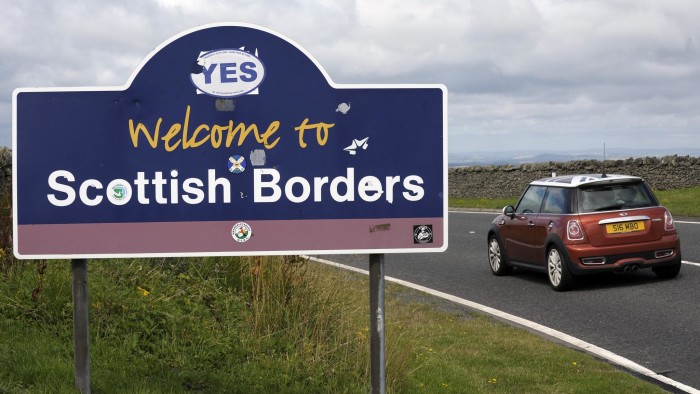Borders held dear to English and Scots

Roula Khalaf, Editor of the FT, selects her favourite stories in this weekly newsletter.
Unspoilt, untamed and in past centuries a byword for lawlessness . . . these are the wild landscapes that lie north of Hadrian’s Wall but south of England’s border with Scotland.
In the debate over Scottish independence, Hadrian’s Wall has sometimes been used as a synonym for the border. That is not correct, and never has been. Today, in some places there are 60 miles between the wall and the border. The area between includes most of Newcastle and North Tyneside and much of Northumberland. It has England’s starriest skies, its biggest working forest and man-made lake at Kielder, the vast Otterburn army training area, the remote Cheviot border ridge, imposing castles and stunning coastlines.
According to Hadrian’s biographer, the Wall from the Solway Firth in the west to the coastal reaches of the River Tyne in the east was built “to separate Romans from barbarians”. For a while the Romans shifted the boundary further north to what is now central Scotland with the Antonine Wall but withdrew after only eight years, leaving the “barbarians” to fight over it among themselves. And fight they did, for more than a millennium.
In the 7th century, the Christian warrior kings of the Kingdom of Northumbria achieved domination from the Firth of Forth to the Humber. Later, the border areas were riven by centuries of feudal warfare between English and Scottish kings and nobles. In border battles such as Otterburn and Flodden, thousands were slaughtered.
Remarkably, direct connections survive today. The present 12th Duke of Northumberland, Ralph Percy, is the descendent of Harry Hotspur and his brother Sir Ralph Percy who fought – and lost – against the Scottish Earl of Douglas at Otterburn in 1388. The present duke lives partly at Alnwick Castle, for centuries a target for Scottish attack, and has large landholdings both sides of the border. He has spoken publicly of his hope that the Scots vote No.
Rural Northumberland retains cultural crossovers with Scotland, too: it has its own black and white tartan and the Northumbrian smallpipes, described by one (English) expert as “perhaps the most civilised of the bagpipes”.
And today, despite some irritation over perceived state largesse to Scotland, many people on the English side of the border sympathise with Scottish antipathy to Westminster. Fundamentally, many Northumbrians feel kinship with the Scots.
“Julius Caesar and the Romans were on the warpath for 300 years and everybody got conquered – except the Scots,” says Hilary Wilshaw, a retired Berwick history teacher. “In a way, I feel a grudging admiration.”
The present border was largely fixed on September 25, 1237, by the Treaty of York, signed by Alexander II of Scotland and Henry III of England. It runs for 96 miles from the Solway Firth to the North Sea, ending just north of the River Tweed and Berwick – a town which has changed hands 13 times between England and Scotland. In the 16th century, most of Elizabeth I’s defence budget was spent on protecting Berwick against the Scots and their allies, the French.
Berwick remains an Anglo-Scottish blend. Because the border shoots northwards as it heads east, Berwick is on the same east-west line as Islay and is well to the north of the Scottish Borders.
From the 14th to the 17th centuries, the border region was, in one writer’s memorable phrase, “Britain’s Afghanistan”. Reivers, lawless clans driven by revenge and pride in their family names, pillaged and terrorised the area. With the union of the crowns in 1603, bringing the accession of James VI of Scotland to the English throne, the rule of law began to be imposed. The treaty of union followed in 1707.
Today the English border lands, including the sparsely populated Northumberland National Park, are a haven for stargazers, walkers and red squirrels. After centuries of discord, there is peace and tranquillity. Local people hope that will not change, whatever else may after Thursday.
Comments